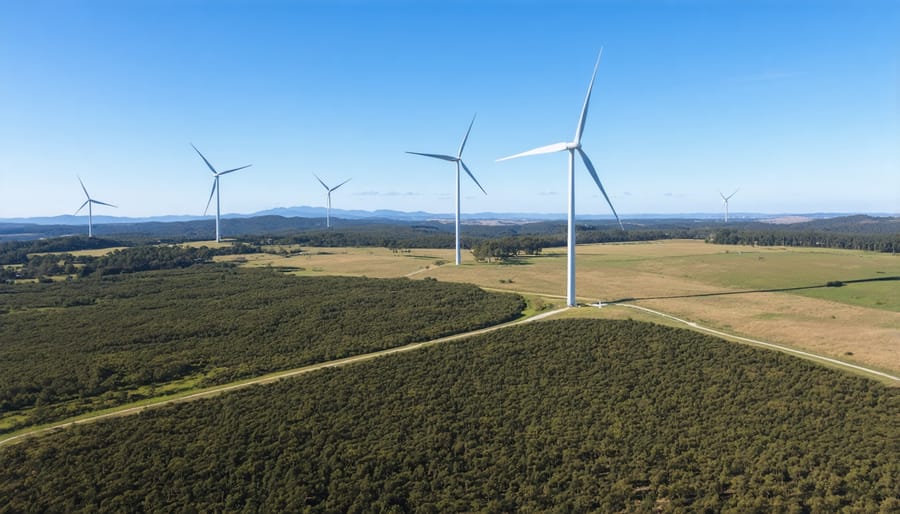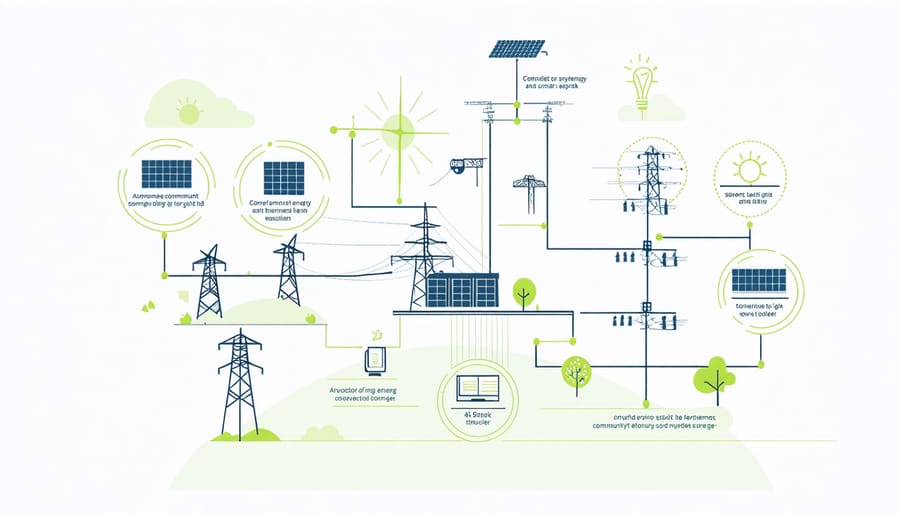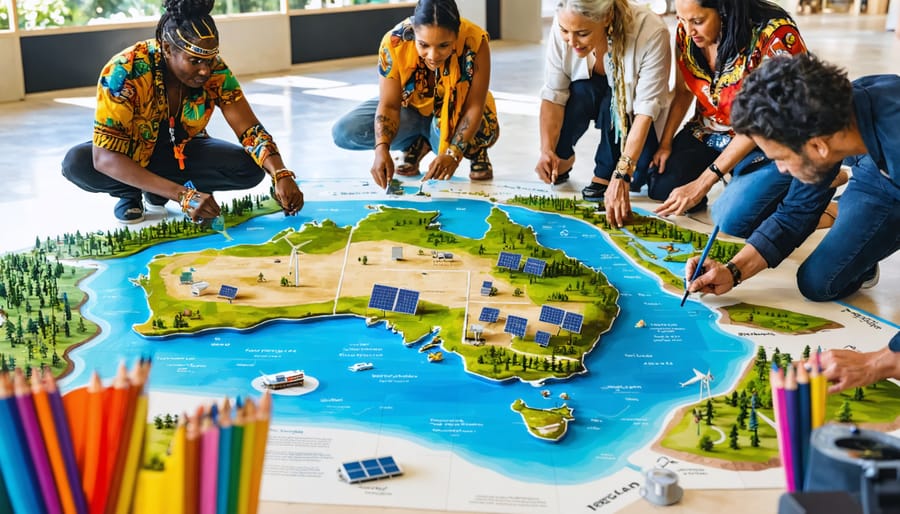Across Australia’s diverse communities, a powerful transformation is taking shape as neighborhoods take control of their sustainable future through community-led development initiatives. From Indigenous-led renewable projects in remote areas to urban sustainability cooperatives in major cities, local groups are revolutionizing how communities design, implement, and benefit from development projects.
When residents become architects of their own progress, extraordinary outcomes emerge. Communities that embrace local leadership in development consistently report higher project success rates, stronger social cohesion, and more equitable distribution of benefits compared to top-down approaches. In the renewable energy sector alone, community-led projects have achieved up to 40% greater adoption rates and significantly higher long-term sustainability.
This movement represents more than just local empowerment – it’s a fundamental shift in how we approach sustainable development. By combining traditional knowledge with modern innovation, Australian communities are creating resilient, adaptable solutions that address unique local challenges while contributing to broader national sustainability goals. From small-scale solar initiatives to comprehensive waste management systems, these grassroots efforts are proving that when communities lead, lasting positive change follows.
The momentum behind community-led development isn’t just changing neighborhoods – it’s reshaping our entire approach to sustainable progress in Australia.
The Power of Community-Led Energy Partnerships
What Makes Energy Partnerships Community-Led?
Community-led energy partnerships are characterized by their grassroots approach, where local residents and stakeholders take an active role in shaping their energy future. These initiatives go beyond traditional top-down models by placing decision-making power directly in the hands of community members. Much like renewable energy innovation hubs, they thrive on collaboration and local expertise.
The defining principles include inclusive participation, where all community members have a voice in the planning process, transparent governance that ensures accountability, and fair distribution of benefits among participants. Successful partnerships typically feature a strong focus on capacity building, helping community members develop the skills needed to manage and maintain energy projects effectively.
What sets these initiatives apart is their emphasis on local ownership and control. Whether it’s a solar farm in regional Victoria or a bioenergy facility in rural Queensland, these projects are designed to reflect community values and meet specific local needs. They often incorporate traditional knowledge and practices, particularly in Indigenous communities, while embracing innovative sustainable technologies.
The most effective partnerships also prioritize long-term sustainability, both environmental and economic, ensuring that projects continue to benefit the community for generations to come.
Benefits Beyond Power Generation
Community-led energy projects deliver far more than just renewable power to local areas. These initiatives create lasting social bonds as neighbours work together towards shared sustainability goals, fostering a stronger sense of community pride and resilience. Local businesses benefit from new opportunities in construction, maintenance, and operations, while training programs equip residents with valuable skills in renewable energy technologies.
The economic advantages are particularly significant for regional communities. Revenue generated from community energy projects typically stays within the local economy, supporting everything from infrastructure improvements to community services. Many communities use surplus funds to support local environmental programs, creating a positive cycle of sustainable development.
Environmental benefits extend beyond reduced carbon emissions. These projects often incorporate land rehabilitation, protect native habitats, and promote biodiversity. Communities gain a deeper understanding of environmental stewardship through direct involvement in sustainable energy production. This hands-on experience leads to broader adoption of sustainable practices, from household energy efficiency to waste reduction initiatives.
The collaborative nature of these projects also strengthens community decision-making capabilities, empowering residents to take active roles in shaping their energy future and local development priorities.
Success Stories: Communities Leading the Way
The Hepburn Wind Story
The Hepburn Wind project stands as a shining example of what communities can achieve when they unite for sustainable change. Located in Leonards Hill, Victoria, this pioneering initiative became Australia’s first community-owned wind farm when it launched in 2011. The project emerged from grassroots action, when local residents decided to take climate action into their own hands.
The journey began in 2004 when a group of Daylesford and Hepburn Springs community members formed a cooperative to develop their own renewable energy project. Through extensive community consultation, careful planning, and remarkable persistence, they raised $9.7 million from over 2,000 members to fund two 2.05 MW wind turbines.
The wind farm now generates enough clean electricity to power more than 2,000 homes, effectively matching the residential power needs of nearby Daylesford. Beyond power generation, the project delivers significant social and economic benefits to the local community. A portion of the revenue is channeled into a community fund that supports local sustainability initiatives and social projects.
What makes Hepburn Wind truly remarkable is its demonstration of community ownership in action. The project has inspired numerous other communities across Australia to explore similar initiatives, creating a ripple effect of positive change. It serves as a powerful testament to how local communities can lead the transition to renewable energy while maintaining control over their energy future.

Byron Bay’s Bioenergy Revolution
In the heart of New South Wales, Byron Bay has emerged as a shining example of community-driven sustainability through its innovative bioenergy facility. The community took a creative approach to their waste management challenges by transforming organic waste into renewable energy, creating a circular economy that benefits both the environment and local residents.
The Byron Bay Bioenergy Facility, launched in 2019, processes over 20,000 tonnes of organic waste annually from local businesses and households. This waste, which would otherwise end up in landfills, is now converted into biogas through anaerobic digestion. The facility generates enough electricity to power approximately 1,500 homes while simultaneously producing nutrient-rich organic fertilizer for local farms.
What makes Byron Bay’s initiative truly remarkable is the level of community engagement. Local businesses, including restaurants and food processors, actively participate in waste separation programs. The council organized educational workshops to help residents understand the importance of proper waste sorting and its impact on the bioenergy process.
The project has created new jobs, reduced landfill costs, and decreased the shire’s carbon emissions by an estimated 20%. More importantly, it has fostered a sense of pride and ownership among community members, who now see their waste as a valuable resource rather than a problem to be disposed of.
Byron Bay’s success has inspired neighboring communities to explore similar initiatives, proving that local action can drive significant environmental change while building stronger, more resilient communities.
Building Effective Energy Transition Partnerships

Engaging Your Community
Building strong community support is essential for successful community-led development initiatives. Start by identifying local champions who can rally neighbours and inspire action. These passionate individuals often become the driving force behind sustainable projects and help maintain momentum when challenges arise.
Create opportunities for meaningful dialogue through community forums, workshops, and informal gatherings. Consider hosting regular “sustainability sundowners” where residents can share ideas and concerns in a relaxed setting. These events help build trust and encourage participation from diverse community members.
Effective engagement relies on clear, inclusive communication. Use multiple channels to reach different demographics – from social media and local newspapers to community noticeboards and door-to-door conversations. Remember to communicate in plain language and provide information in various community languages when needed.
Demonstrate early wins by starting with smaller, achievable projects that show visible results. This might include community gardens, local clean-up days, or energy-saving initiatives. Success breeds success, and these early achievements help build confidence and enthusiasm for larger projects.
Partner with local schools, businesses, and community organisations to broaden your reach and pool resources. These partnerships create a stronger foundation for long-term sustainability and help embed the initiative within existing community structures.
Most importantly, ensure decision-making processes are transparent and inclusive. Regular updates, open meetings, and clear pathways for community input help maintain trust and encourage ongoing participation in your development initiatives.
Securing Technical Support and Funding
Securing technical support and funding for community energy projects requires a strategic approach combining various resources and partnerships. Many Australian communities have successfully navigated this challenge through clean energy partnerships with government agencies, private sector organizations, and expert consultants.
The Australian Renewable Energy Agency (ARENA) offers substantial grants and funding opportunities specifically designed for community-led initiatives. Local councils often provide seed funding and technical expertise, while state governments may offer matched funding programs to help projects get off the ground.
Beyond government support, communities can tap into resources from organizations like the Community Power Agency and Sustainability Victoria, which provide valuable guidance, toolkits, and networking opportunities. Many successful projects have benefited from partnerships with universities and research institutions, accessing cutting-edge technical expertise and research capabilities.
Private sector involvement through impact investors and ethical finance institutions has become increasingly common, offering alternative funding pathways. Some communities have found success with cooperative funding models, where local residents become shareholders in the project, creating a sustainable ownership structure while securing necessary capital.
Professional networks and industry associations also play a crucial role, offering mentorship programs and connecting communities with experienced practitioners who can guide them through technical and regulatory challenges. These relationships often prove invaluable for long-term project success and community capacity building.
Overcoming Common Challenges
Community-led development initiatives often face hurdles, but successful projects across Australia demonstrate effective solutions to these challenges. One common obstacle is securing initial funding, which many communities overcome through innovative financing models like crowd-funding campaigns and community investment schemes. The Hepburn Wind project in Victoria, for instance, raised over $9 million through community shares, proving that local financial support can drive substantial projects forward.
Communication barriers between stakeholders often slow progress, but establishing regular community forums and transparent decision-making processes helps maintain momentum. The creation of working groups with clear roles and responsibilities ensures everyone stays informed and engaged. Some communities have found success by appointing local champions who facilitate dialogue between technical experts and residents.
Technical expertise gaps can be bridged through partnerships with universities and industry professionals. Many communities have implemented mentorship programs, connecting experienced project managers with local teams to build capacity and knowledge. Regular workshops and skill-sharing sessions help develop local expertise over time.
Regulatory complexity often seems daunting, but successful communities tackle this by forming alliances with similar projects and sharing learnings. Some groups have created simplified guidance documents to help others navigate approval processes. Building relationships with local councils and regulatory bodies early in the project timeline has proven crucial for smooth implementation.
Remember, challenges are stepping stones to success when approached with creativity and collaboration. The growing network of community energy projects across Australia provides a valuable support system for emerging initiatives.
The Future of Community Energy in Australia
New Technologies and Possibilities
Emerging technologies are revolutionizing how communities approach sustainable energy development, creating exciting possibilities for Australia’s green energy future. Smart microgrids are enabling neighbourhoods to generate, store, and trade energy locally, while advanced battery systems are making energy independence more achievable than ever. Innovative blockchain platforms are simplifying peer-to-peer energy trading, allowing residents to buy and sell excess solar power directly within their community.
Virtual power plants (VPPs) are gaining traction, connecting household solar systems and batteries to create powerful community-wide energy networks. These systems use artificial intelligence to optimize energy distribution and storage, reducing costs while maximizing renewable energy usage. Additionally, new bio-digestion technologies are making it easier for communities to convert organic waste into biogas, creating closed-loop energy systems that benefit both the environment and local economies.
Mobile apps and digital platforms are empowering communities to monitor and manage their energy consumption in real-time, fostering greater engagement and awareness in sustainable practices. These technological advances are making community-led energy initiatives more accessible, efficient, and economically viable than ever before.

Policy Support and Infrastructure
Australian governments at all levels are increasingly recognizing the vital role of community-led energy initiatives in achieving sustainable development goals. Recent policy frameworks have created pathways for communities to establish their own renewable energy projects, with specific funding allocations and streamlined approval processes supporting local initiatives.
The Clean Energy Finance Corporation has established dedicated funding streams for community energy projects, while state governments have introduced renewable energy zones that prioritize community participation. These frameworks complement broader cross-border energy initiatives, creating a supportive ecosystem for grassroots energy innovation.
Infrastructure development has kept pace with these policy changes, with investments in grid connections, energy storage facilities, and smart metering systems making it easier for communities to generate and distribute their own power. Local councils are also playing their part by simplifying planning requirements and offering technical support to community groups.
This enabling environment has resulted in a surge of successful community energy projects, from solar gardens in regional towns to bioenergy facilities in farming communities, demonstrating the practical impact of well-designed policy support.
The journey towards community-led development represents a powerful shift in how we approach sustainable energy solutions in Australia. Through the examples and strategies discussed, we’ve seen how local communities can take charge of their energy future while creating lasting environmental and economic benefits.
The success stories from regional communities demonstrate that when people come together with a shared vision, remarkable transformations are possible. From small-town bioenergy projects to large-scale renewable initiatives, these achievements prove that grassroots movements can drive significant change.
Moving forward, communities across Australia have unprecedented opportunities to lead their own development projects. The key lies in fostering strong partnerships, securing community buy-in, and maintaining open dialogue among all stakeholders. By embracing local knowledge and combining it with technical expertise, we can create sustainable solutions that truly serve community needs.
For those inspired to take action, the first step is to gather like-minded individuals and start conversations about local energy needs and opportunities. Connect with existing community energy groups, engage with local government, and explore available funding options. Remember, every successful community-led project started with a simple conversation and a shared dream of a better future.
Together, we can build a network of empowered communities leading Australia’s transition to a sustainable energy future. The time to act is now, and the power lies in our hands to create lasting positive change for generations to come.

